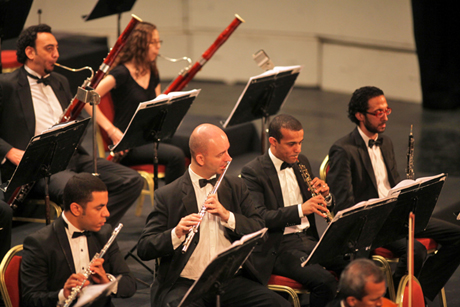On May 18, yet another delightful concert was given by Cairo Symphony Orchestra under the baton of Egyptian conductor Hisham Gabr. The evening's programme included works by Rossini, Saint-Saëns and Sibelius and featured cellist Ayman El Hanbouly. The same concert was performed on 19 May in Alexandria.
The concert opened with G. Rossini’s (1792-1868) Semiramide overture. Having Rossini on the programme is always a welcomed treat for the audiences worldwide. Semiramide Opera, a melodrama based on a Voltaire’s play Semiramis, is inspired by a Babylonian legend. Being one of Rossini’s finest compositions, this overture has become a popular concert piece.
It is interesting to note that Rossini composed Semiramide overture after he had finished the opera score – in only 33 days! As such, he included some of its elements to the Overture.
Rossini puts the dark notes and the grieving horns (Andantino) at the opening of the overture but soon moves to vivacious and light-hearted spirit. The listener is hence taken into typical Rossinian crescendos, which Gabr intricately controlled before this short and poignant composition ends in a frenzy.
Gabr has always showed a special affinity to Rossini’s music. He excels in rendering the Italian composer’s spirited music with its wit, vivacity and brightness. Under his baton, audiences have already heard other Rossini overtures, including La Scala di Seta, La Gazza Ladra etc.
Looking back into the composer's history, having completed Semiramide, Rossini left Italy to France.
And so did Hisham Gabr, who took the audience on a journey into Camille Saint-Saëns’ (1835-1921), French composer's beautiful cello concerto no. 1 in A minor Op. 33 featuring Egyptian cello virtuoso Ayman El-Hanbouly.
Saint-Saëns had written and dedicated this difficult, yet admirable piece for the Auguste Tolbecque, renowned cello virtuoso as well as author of Gymnastique du Violoncelliste, L’Art du Luthier, and other books.
It's worth noting that El-Hanbouly and Gabr first collaborated in an unforgettable concert in May 2011, performing Elgar’s famous Cello Concerto in E minor with great success.
In cello concerto no. 1, the prolific French composer modified the traditional concerto form, compressing the three classical movements into one continuous movement, yet keeping the fast-slow-fast scheme.
A brief chord replacing the usual orchestral introduction opened the concerto, then the cello played the main theme passionately (in Allegro non troppo). After the development comes an elegiac lyrical tune (Allegretto con moto) and the main theme is recapitulated with great agitation before the end (Allegro non troppo). Throughout the whole performance, Gabr led a delicate integration of the cello with the orchestra.
The concerto is technically very challenging for the soloist, especially towards the end where the whole register of the cello is exploited. Besides his great technical skills, El-Hanbouly is a very sensitive and expressive musician. His sincere emotional performance was quite moving and his vibratos, as usual, amazing. No wonder he was warmly acclaimed by the audience.
In the second part of the concert, Gabr resumed his journey to the north, reaching Finland, the land of a thousand lakes and whooper swan, inviting the audience to explore the beauty of the great Finnish composer Jean Sibelius (1865-1957) and his first symphony.

Hisham Gabr conducting Cairo Symphony Orchestra, 18 May 2013.(Photo: Sherif Sonbol)
How could the audience not follow?
A lonely clarinet, meditating and wandering over a soft drum roll opened the symphony, immediately captivating the audience.
Then the Andante ma non troppo turned to Allegro energico with the orchestra entry. The listener follows many alluring melodies alternating with bursting vivacious waves suggesting breathtaking scenery, cool fresh air, blue skies, quiet lakes, impressive forests, even birds singing through the flute over gentle harp rippling in the second movement. Nature has always been in Sibelius music.
The recurrence of tension and release cycles in the symphony led critics to relate it to the Finnish struggle against Russian occupation. But Sibelius insisted that it was pure music.
The third movement Scherzo is cheerfully vigorous. Several changes in tempo intensified the passionate finale and after a tumultuous climax, two soft pizzicato chords marked the subtle end.
Throughout the symphony solo lines for different instruments (clarinet, violin, viola, cello, etc) were remarkably played by the orchestra members. At the same time, Gabr’s interpretation was refined, revealing the meditative aspect of the symphony, its freshness and purity while observing a suitable pace allowing the music to breathe and bloom.
There is a worldwide trend this year to focus on 20th century classical music. Performing Sibelius fits in this context for the significant contributions it brought to 20th century symphonic thoughts (the symphony's actual revised score dates from 1900).
Sibelius adopted an "organic" technique where, departing from a motif or seed (the clarinet solo) that grows, greater ideas and themes develop in different forms.
It has become a standard to immediately mention Mahler when Sibelius is brought up. Let us, then, instead, quote British composer Sir Peter Maxwell Davies (b. 1934): "Symphonies are like cathedrals in music, imposing, carefully organised artefacts designed to uplift, inspire and illuminate."

The wind section of the Cairo Symphony Orchestra (Photo: Sherif Sonbol)
Short link: